No photos today. I have finally returned to Florence, which really is my favorite city out of all that I have seen (with a close second being the utterly charming Lucca). I am indescribably happy to be back, and have treated myself to a truly wonderful meal of green tortelloni with truffle, ricotta, sage, and butter, plus red wine (these Tuscan reds are so spicy and alive!), pannacotta, coffee, biscotti... truly a delight.
My current hotel does not have internet, so I am not sure when I will update next with photos, but I will be thinking fondly of all of you. <3 Thank you all so much for your kind comments. I can't describe how happy I am that you are enjoying this blog.
Before I log off from this internet café, I would like to announce that I will be offering prints of all of my photos when I return to the States. I print through Kinko's because their rates are reasonable and the print quality is very good. If any of my photos catch your eye, please feel free to contact me (comment, e-mail, LJ, or Facebook are all fine) and we can discuss price, size, method of delivery, or any other questions that you might have. If I owe you for Christmas/other holiday/birthday/gift of any kind, you may end up with some whether you ask or not!
Ciaociao! <3
29 December 2010
28 December 2010
Day 12: Museo Sforzesco
Today was cold! So, so cold. I don't know what the temperature was precisely, just that after walking around for only a few minutes, I had a headache from the cold. This put something of a damper on my plans to see as many museums as possible, since I just didn't feel able to hike all over town to track them down, but I did see a number of the museums at Castello Sforzesco.
Adjacent to Piazza del Duomo, the closest metro stop to the castle from my hotel, is a glass-domed area called the Galleria. It's full of expensive brand-named shops, restaurants and eateries (including the bar where Campari, the famous bright-red Italian bitter, was introduced), and artwork--paintings on the ceiling, and tile mosaics on the ground.

Celebrations of Italy's unification (or Risorgimento in the native tongue) can be seen all over Milan. The two most prominent mosaics in the Galleria are in honor of Italy's two historic capital cities since unification; an image of the wolf suckling Romulus and Remus for Rome, and an image of a bull for Turin (whose name in Italian, Torino, means "little bull"). Popular legend says that, for good luck, you plant your heel on the testicles of the bull and spin in place. There is always a crowd of people around the bull to watch the ritual and wait for their turn, and it is so popular that a hole several inches deep has been worn into the floor of the Galleria.
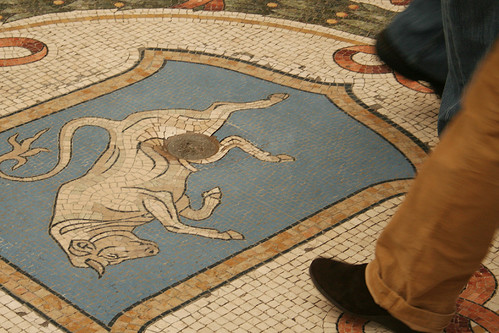
From the Duomo, Castello Sforzesco is a few minutes' walk down Via Dante, an all-pedestrian street lined with merchant stalls, cafes, and, of course, designer fashion and luxury shops. The castle contains a generous number of museums from pre-Roman art to Renaissance furniture, from Neolithic Italian archaeology to Egyptian mummies (yes, they have actual mummies). These are all housed in various portions of the castle, so as you walk among Gothic pillars and Crusades-era sarcophagi, you simultaneously witness the castle's twisting hallways and frescoed ceilings. One of my favorite rooms was the Sala delle Asse, in which the wall supports and ceilings had been painted with trees and interlacing branches by Leonardo da Vinci himself.
Castello Sforzesco houses Michelangelo's last sculpture, the incomplete Rondanini Pietà.

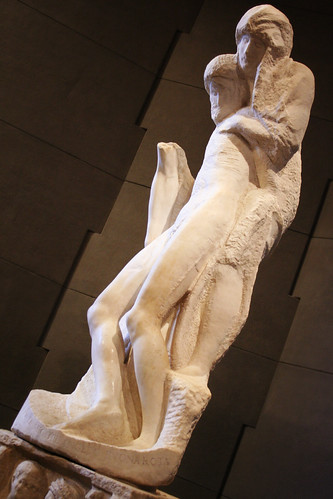
All in all, I saw three exhibits: ancient art (which included the Pietà as well as a variety of sculpture and glass from the 9th through 16th centuries), archaeology (Italian archaeological findings from the Neolithic period to the Iron Age), and Egypt (coffins, mummies, artifacts, and papyri from 3000 BCE to Ptolemaic Egypt).
Tomorrow, I will return to Florence.
Adjacent to Piazza del Duomo, the closest metro stop to the castle from my hotel, is a glass-domed area called the Galleria. It's full of expensive brand-named shops, restaurants and eateries (including the bar where Campari, the famous bright-red Italian bitter, was introduced), and artwork--paintings on the ceiling, and tile mosaics on the ground.

Celebrations of Italy's unification (or Risorgimento in the native tongue) can be seen all over Milan. The two most prominent mosaics in the Galleria are in honor of Italy's two historic capital cities since unification; an image of the wolf suckling Romulus and Remus for Rome, and an image of a bull for Turin (whose name in Italian, Torino, means "little bull"). Popular legend says that, for good luck, you plant your heel on the testicles of the bull and spin in place. There is always a crowd of people around the bull to watch the ritual and wait for their turn, and it is so popular that a hole several inches deep has been worn into the floor of the Galleria.

From the Duomo, Castello Sforzesco is a few minutes' walk down Via Dante, an all-pedestrian street lined with merchant stalls, cafes, and, of course, designer fashion and luxury shops. The castle contains a generous number of museums from pre-Roman art to Renaissance furniture, from Neolithic Italian archaeology to Egyptian mummies (yes, they have actual mummies). These are all housed in various portions of the castle, so as you walk among Gothic pillars and Crusades-era sarcophagi, you simultaneously witness the castle's twisting hallways and frescoed ceilings. One of my favorite rooms was the Sala delle Asse, in which the wall supports and ceilings had been painted with trees and interlacing branches by Leonardo da Vinci himself.
Castello Sforzesco houses Michelangelo's last sculpture, the incomplete Rondanini Pietà.


All in all, I saw three exhibits: ancient art (which included the Pietà as well as a variety of sculpture and glass from the 9th through 16th centuries), archaeology (Italian archaeological findings from the Neolithic period to the Iron Age), and Egypt (coffins, mummies, artifacts, and papyri from 3000 BCE to Ptolemaic Egypt).
Tomorrow, I will return to Florence.
27 December 2010
Day 11: Milano Sfaccettata
Well, I had a small adventure with regard to my hotel. It was a listing in one of Rick Steve's guidebooks from 2008. I called in the morning to reserve a room, being sure to ask, "is this Hotel XYZ?" and the man on the phone said that yes, it was, so I made my reservation. When I arrived at the address, the hotel had a completely different name, different management, different prices (though, fortunately, not outrageously so), and fewer of the amenities listed in the book. I'm slightly bitter, but I suppose that that is my karmic retribution for accessing the book via Google Books instead of ponying up for a legal and up-to-date copy.
Also part of my karmic retribution is that the Museo del Duomo was, in fact, closed; the Duomo itself, however, was open as promised, and it was spectacular.
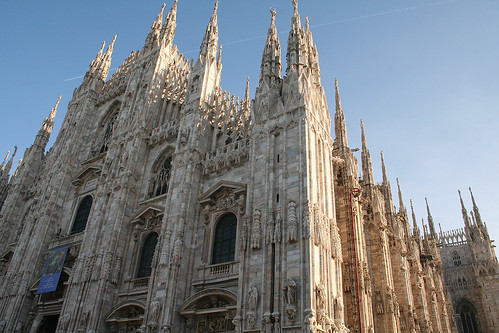
Unlike many other cathedrals in Italy, il Duomo di Milano is built in the Gothic style. It lacks the smooth cupolas and frescoes characteristic of Renaissance architecture, instead opting for jagged spires and angular shapes on the exterior, and an interior that contrasts simple stonework and vividly stained glass.
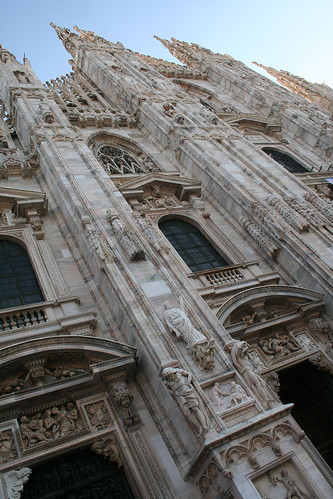
Construction began in the late 1300s; heavy French influence in the early years is likely the reason for its Gothic design. Napoleon Bonaparte ordered the completion of the façade in 1805, and it was not until 1965 that the last elements of the building were officially completed. Thus, the Milanese dialect has the expression fabrica del dom, "building the cathedral," which figuratively refers to a task that is egregiously long or difficult.

Opinions on the cathedral vary widely, from the eloquent praises of Mark Twain to the damnations of Oscar Wilde.
The interior architecture itself features large but fairly boring columns, some instances of detailed carving over the chapels and niches, and vaulting ceilings without much to offer per se. The stained glass, however, is another story.
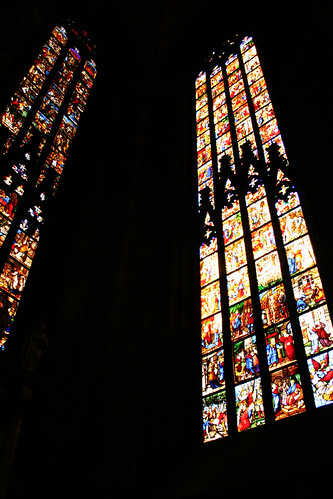
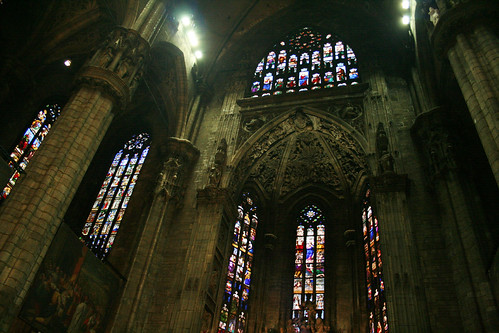
The windows depict people and scenes relevant to the Christian faith in shocking color, and when the angle of the sun is right, gray stone is transformed into glowing frescoes.
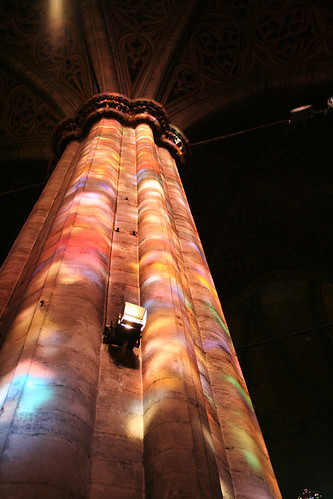
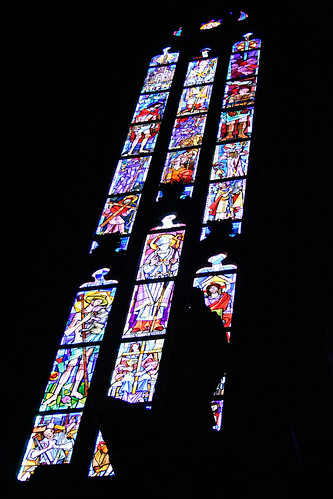
During November and December, paintings of St. Charles Borromeo by a variety of Renaissance painters are hung along the walkways. The Duomo also houses the largest pipe organ in Italy, a small part of which is visible here on the left.


For a fee, you can climb a staircase to the roof of the cathedral and walk along the north-facing side. (For a slightly larger fee, you can take an elevator.) I recommend it, because otherwise it's essentially impossible to see much of the roof's architecture, including dozens of statues and the Madonnina that sits on the main spire, over 350 feet above ground level.
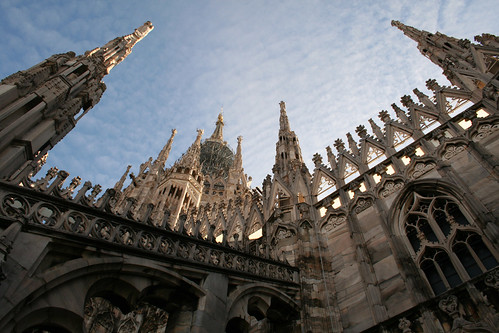
At the end of the day, I have to side with Mark Twain; I find the array of contrasts in the Duomo's architecture beautiful in spite of its discord. It is a perplexing juxtaposition of solidity and ethereality. Now that I've met my sesquipedalian quota for the week, here's another photo of the façade.
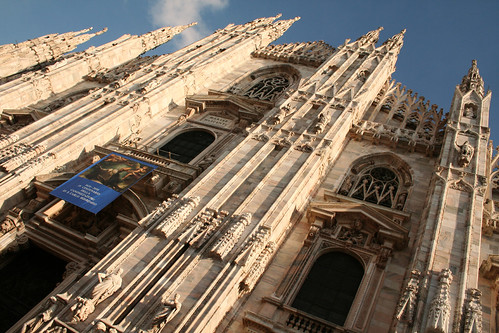
I took a walk around the Duomo district and ended up in Parco Sempione by Castello Sforzesco, a 14th century castle that was once home to the Duchy of Milan, as well as Spanish and Austrian forces in later years. It's full of museums, but--as we've all come to expect on a Monday--they were closed.
Given that tomorrow is not a Monday, it will be a museum day.
Also part of my karmic retribution is that the Museo del Duomo was, in fact, closed; the Duomo itself, however, was open as promised, and it was spectacular.

Unlike many other cathedrals in Italy, il Duomo di Milano is built in the Gothic style. It lacks the smooth cupolas and frescoes characteristic of Renaissance architecture, instead opting for jagged spires and angular shapes on the exterior, and an interior that contrasts simple stonework and vividly stained glass.

Construction began in the late 1300s; heavy French influence in the early years is likely the reason for its Gothic design. Napoleon Bonaparte ordered the completion of the façade in 1805, and it was not until 1965 that the last elements of the building were officially completed. Thus, the Milanese dialect has the expression fabrica del dom, "building the cathedral," which figuratively refers to a task that is egregiously long or difficult.

Opinions on the cathedral vary widely, from the eloquent praises of Mark Twain to the damnations of Oscar Wilde.
The interior architecture itself features large but fairly boring columns, some instances of detailed carving over the chapels and niches, and vaulting ceilings without much to offer per se. The stained glass, however, is another story.


The windows depict people and scenes relevant to the Christian faith in shocking color, and when the angle of the sun is right, gray stone is transformed into glowing frescoes.


During November and December, paintings of St. Charles Borromeo by a variety of Renaissance painters are hung along the walkways. The Duomo also houses the largest pipe organ in Italy, a small part of which is visible here on the left.


For a fee, you can climb a staircase to the roof of the cathedral and walk along the north-facing side. (For a slightly larger fee, you can take an elevator.) I recommend it, because otherwise it's essentially impossible to see much of the roof's architecture, including dozens of statues and the Madonnina that sits on the main spire, over 350 feet above ground level.

At the end of the day, I have to side with Mark Twain; I find the array of contrasts in the Duomo's architecture beautiful in spite of its discord. It is a perplexing juxtaposition of solidity and ethereality. Now that I've met my sesquipedalian quota for the week, here's another photo of the façade.

I took a walk around the Duomo district and ended up in Parco Sempione by Castello Sforzesco, a 14th century castle that was once home to the Duchy of Milan, as well as Spanish and Austrian forces in later years. It's full of museums, but--as we've all come to expect on a Monday--they were closed.
Given that tomorrow is not a Monday, it will be a museum day.
26 December 2010
Day 10: In Treno II
Once again, no photos today. I took the long train ride from Rome to Milano Centrale, rather worried that I might have to stand for the entire six-hours-and-some trip because I had not reserved a seat in advance; fortunately, I only had to stand for a little while here and there. People getting on and off throughout the trip occasionally left seats open, and I was able to sit for the majority of the journey. I do wish that more of the trip had been in daylight, because what little of the terrain I could see before sunset was remarkably beautiful. Deep-green hills, forests, and muddy rivers all covered in gentle mist.
It seems to be true almost everywhere that the best museums are closed on Mondays, but I believe that Milan's Duomo and its associated museum is open, so that is my plan for tomorrow.
It seems to be true almost everywhere that the best museums are closed on Mondays, but I believe that Milan's Duomo and its associated museum is open, so that is my plan for tomorrow.
25 December 2010
Day 9: Natale in Vaticano
Buon Natale! ♥ Buone feste!
I am not religious in any fashion whatsoever, but I thought it would be interesting to see a Catholic service in Rome for Christmas. When I asked at the hotel desk where I could find some, they suggested that I go to St. Peter's Basilica... in Vatican City! It was an easy trip on the metro from my hotel near Piazza della Reppublica, and I was fortunate to arrive early enough that the line to get into St. Peter's was not too long.
Piazza di San Pietro. You can see just a few of the statues of saints that surround the entire square, as well as the dome of the basilica itself.
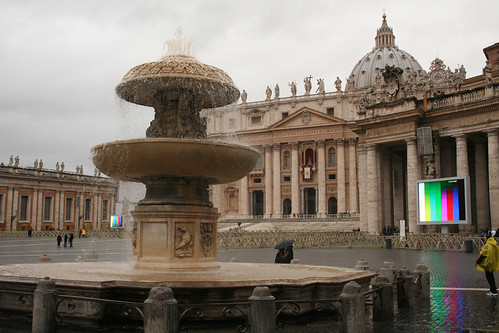
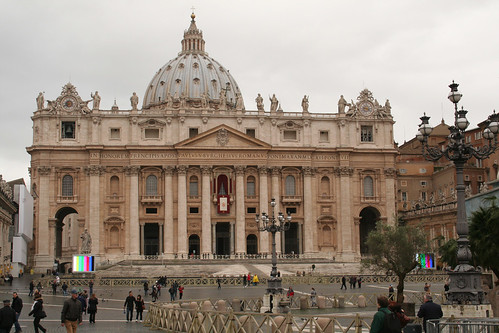
Basilica Sancti Petri is the largest Christian church in the world. It can fit over 60,000 worshipers--9,000 more than Yankee Stadium--and is used for most of the religious ceremonies over which the Pope presides.
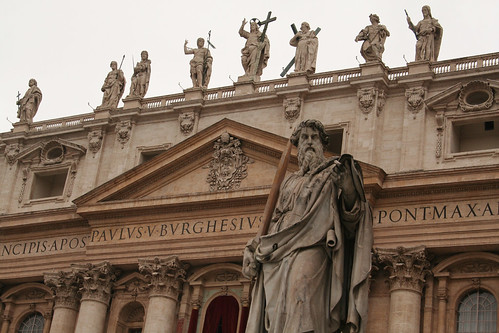
The basilica was constructed on what is said to be the burial site of the martyr St. Peter, next to the Circus of Nero. The original basilica was constructed under the Roman emperor Constantine in the fourth century CE, and was replaced in the 15th and 16th centuries with the current structure, designed predominantly by Michelangelo.
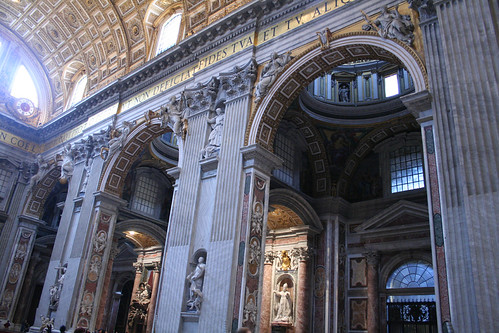
The interior of the basilica is astounding in its detail. Every inch of surface is gilded, carved, or painted. Even the architecture demonstrates this; although the basic form of the structure is a cross, each space branches into smaller and smaller rooms and niches, which house altars, statues, and relics.
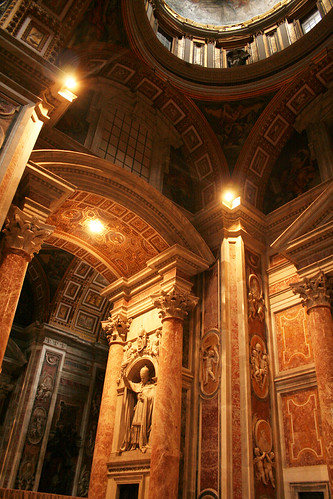

I did not go into the chapel for the mass that morning, but stayed on the other side of the barrier with the other tourists. It was still a magnificent view of things.
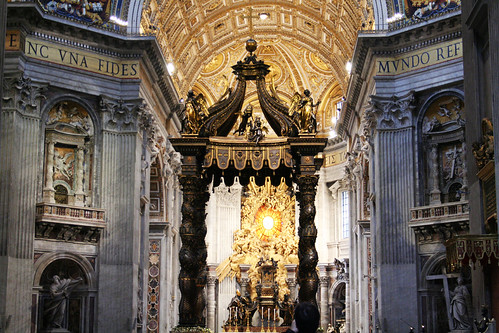
As I was leaving, a little before the end of the mass, I noticed that there was suddenly a huge crowd around the basilica. As it turns out, it was almost time for the Pope's Christmas speech, the Urbis et Orbis!
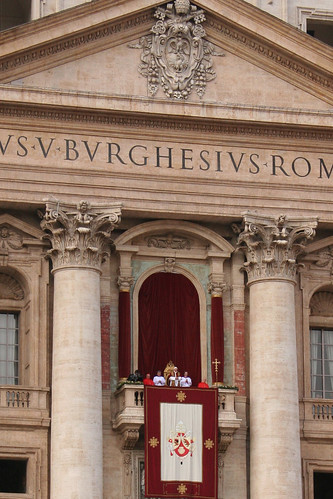
If you open up the very largest version of this photo, you can almost see him.
The address, at least as far as I could understand it, focused on the meaning of Christmas as a time to seek peace and love, asking for reconciliation in the many areas of the world that are hurt by wars, disasters, and political oppression. He ended it by saying "Merry Christmas" (and variations on the theme) in what I read later was sixty-five different languages.
I think that this is a Christmas to remember.
I am not religious in any fashion whatsoever, but I thought it would be interesting to see a Catholic service in Rome for Christmas. When I asked at the hotel desk where I could find some, they suggested that I go to St. Peter's Basilica... in Vatican City! It was an easy trip on the metro from my hotel near Piazza della Reppublica, and I was fortunate to arrive early enough that the line to get into St. Peter's was not too long.
Piazza di San Pietro. You can see just a few of the statues of saints that surround the entire square, as well as the dome of the basilica itself.


Basilica Sancti Petri is the largest Christian church in the world. It can fit over 60,000 worshipers--9,000 more than Yankee Stadium--and is used for most of the religious ceremonies over which the Pope presides.

The basilica was constructed on what is said to be the burial site of the martyr St. Peter, next to the Circus of Nero. The original basilica was constructed under the Roman emperor Constantine in the fourth century CE, and was replaced in the 15th and 16th centuries with the current structure, designed predominantly by Michelangelo.

The interior of the basilica is astounding in its detail. Every inch of surface is gilded, carved, or painted. Even the architecture demonstrates this; although the basic form of the structure is a cross, each space branches into smaller and smaller rooms and niches, which house altars, statues, and relics.


I did not go into the chapel for the mass that morning, but stayed on the other side of the barrier with the other tourists. It was still a magnificent view of things.

As I was leaving, a little before the end of the mass, I noticed that there was suddenly a huge crowd around the basilica. As it turns out, it was almost time for the Pope's Christmas speech, the Urbis et Orbis!

If you open up the very largest version of this photo, you can almost see him.
The address, at least as far as I could understand it, focused on the meaning of Christmas as a time to seek peace and love, asking for reconciliation in the many areas of the world that are hurt by wars, disasters, and political oppression. He ended it by saying "Merry Christmas" (and variations on the theme) in what I read later was sixty-five different languages.
I think that this is a Christmas to remember.
24 December 2010
Day 8: Roma Piovissima
Today, it rained.
I got breakfast at the hotel, then made it about as far as Forum Traiani before it started pouring buckets.
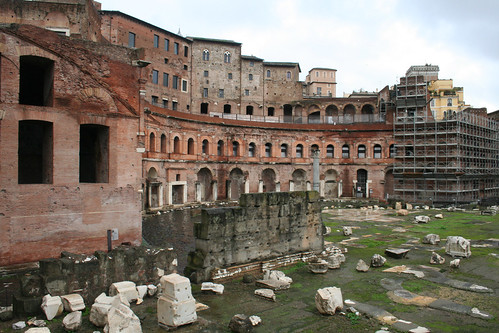
Trajan's Forum is the latest of the Imperial fora, inaugurated around 112 CE.
The areas around the forum are magnificent - just beyond the edges of the busy road, excavations reveal crumbling walls and broken pillars. This goes on for miles, all around the forum, the Colosseum, and the local museums.
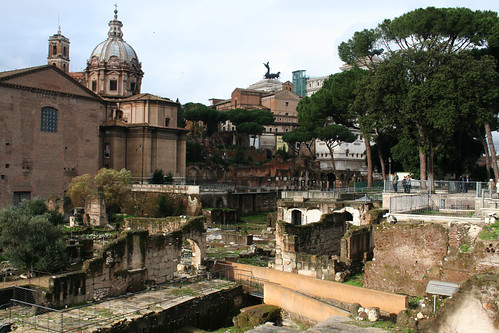
When the rain really started, I bought a cheap umbrella, which kept my head dry during the day's excursions but did nothing for my shoes and pant legs; by mid afternoon, I was waterlogged up to my knees, miserably cold, and a little annoyed at how touristy the whole thing was, so I trudged back to my hotel room and spent the rest of the afternoon doing much-needed laundry in the bathroom sink. (If I ever complain about my washing machine ever again, please slap me.)
On the plus side, I did see the Colosseum.

The outer facade exists around about a third of the whole structure; the rest is an inner wall that is not nearly as polished, but still majestic and perhaps even more palpably ancient.
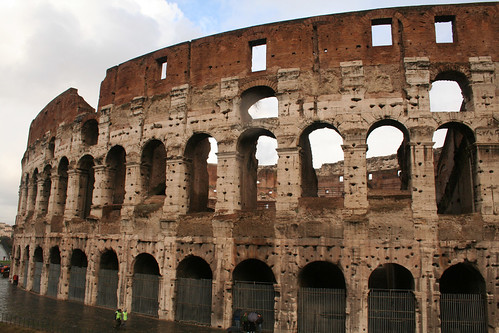
Even in person, it's difficult to appreciate just how big this thing really is.
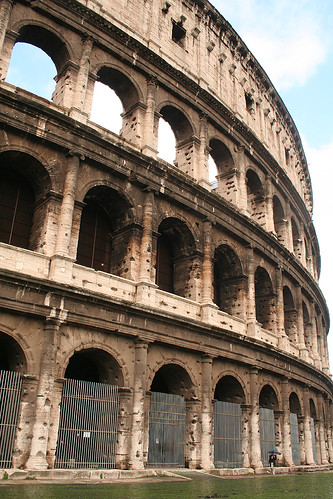
Note the little dude in the lower right for scale.
Originally named the Flavian Amphitheatre, it was constructed in about ten years under emperors Vespasian and Titus, between 70 and 80 CE. The name Colosseum (sometimes Coliseum, a spelling variation that arose in the Middle Ages) derives from a bronze statue, the Colossus, which once stood nearby and depicted various emperors and the god Helios.
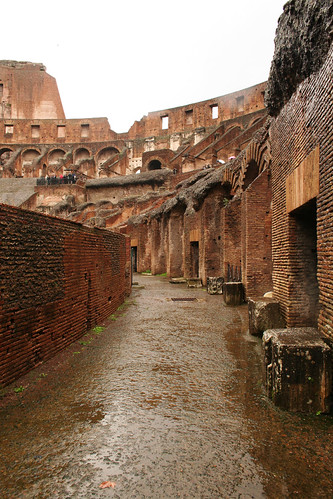
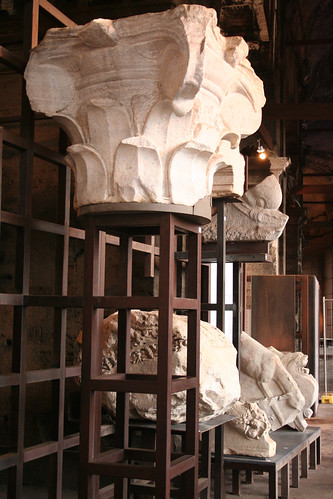
The Colosseum could fit about 50,000 spectators, and over its first 500 years or so, hosted events ranging from gladiatorial combat to animal hunts, to executions, to theatrical productions, to war reenactments.
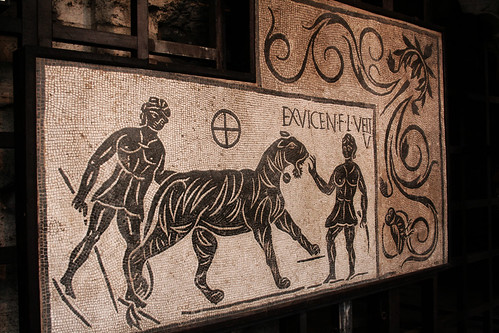
Around the sixth century CE, the Colosseum was alternately converted into a cemetery, a site of Christian worship (due to its symbolism as a place where early Christians were said to be martyred), a stone quarry, a housing development, and a fortified castle. In the 1300s, an earthquake caused much of the outer wall to collapse, and from there, the structure was slowly dismantled to make use of the stone and bronze.

The hypogeum - from Greek, meaning "underground" - was a series of passageways and tunnels equivalent to the backstage of a theatre, allowing performers, props, and animals to be transported without the audience's knowledge. It was covered by a wooden platform, which itself was covered by sand (from which we get the modern word arena, which means "sand" in Latin).
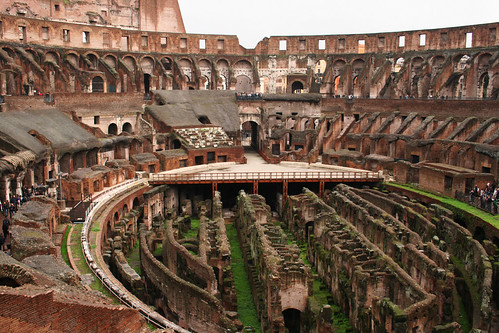
The Arch of Constantine, as visible from the upper levels of the Colosseum.
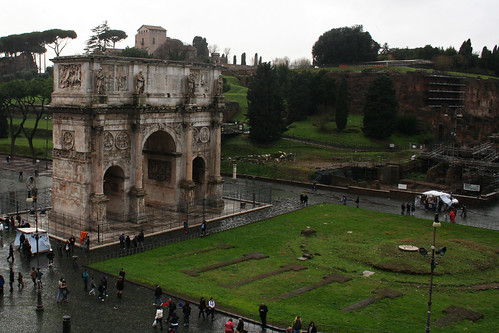
Trivia: approximately two hundred species of plants can be found growing in the Colosseum.
I don't want to downplay how amazing this all is--the architecture, the museums, all of these traces of a world that is at once so far from and so venerated by our culture--because it is amazing. To be able to look at these marvels with my own eyes is like nothing I've ever experienced. The thing is, it's been made into such a touristy experience that it just feels degrading. Mediocre restaurants with names like Café Gladiator charge exorbitant prices knowing that tourists will bite, people walk around in "Roman" costumes outdone by most of my LARP friends and charge 10 Euro for photographs, and I know I'll come off as an elitist and a snob when I say this, but the place is loaded with idiot American tourists who don't have a clue why the place was built or why it's so incredible. (See, elitist snob. I can't help it, it just breaks my Classicist heart a little to hear people around me say things like [and I quote], "So, uh, this was where the Romans fought? Who did they fight?") I suppose my point is this: Rome is the first place I've been to in Italy where I felt like they were really trying to take advantage of me, and I actually felt a little embarrassed for the city, for the way they'd dolled her up and put her on display.
I suppose it's just an unfortunate consequence of being so famous and so great.
I got breakfast at the hotel, then made it about as far as Forum Traiani before it started pouring buckets.

Trajan's Forum is the latest of the Imperial fora, inaugurated around 112 CE.
The areas around the forum are magnificent - just beyond the edges of the busy road, excavations reveal crumbling walls and broken pillars. This goes on for miles, all around the forum, the Colosseum, and the local museums.

When the rain really started, I bought a cheap umbrella, which kept my head dry during the day's excursions but did nothing for my shoes and pant legs; by mid afternoon, I was waterlogged up to my knees, miserably cold, and a little annoyed at how touristy the whole thing was, so I trudged back to my hotel room and spent the rest of the afternoon doing much-needed laundry in the bathroom sink. (If I ever complain about my washing machine ever again, please slap me.)
On the plus side, I did see the Colosseum.

The outer facade exists around about a third of the whole structure; the rest is an inner wall that is not nearly as polished, but still majestic and perhaps even more palpably ancient.

Even in person, it's difficult to appreciate just how big this thing really is.

Note the little dude in the lower right for scale.
Originally named the Flavian Amphitheatre, it was constructed in about ten years under emperors Vespasian and Titus, between 70 and 80 CE. The name Colosseum (sometimes Coliseum, a spelling variation that arose in the Middle Ages) derives from a bronze statue, the Colossus, which once stood nearby and depicted various emperors and the god Helios.


The Colosseum could fit about 50,000 spectators, and over its first 500 years or so, hosted events ranging from gladiatorial combat to animal hunts, to executions, to theatrical productions, to war reenactments.

Around the sixth century CE, the Colosseum was alternately converted into a cemetery, a site of Christian worship (due to its symbolism as a place where early Christians were said to be martyred), a stone quarry, a housing development, and a fortified castle. In the 1300s, an earthquake caused much of the outer wall to collapse, and from there, the structure was slowly dismantled to make use of the stone and bronze.

The hypogeum - from Greek, meaning "underground" - was a series of passageways and tunnels equivalent to the backstage of a theatre, allowing performers, props, and animals to be transported without the audience's knowledge. It was covered by a wooden platform, which itself was covered by sand (from which we get the modern word arena, which means "sand" in Latin).

The Arch of Constantine, as visible from the upper levels of the Colosseum.

Trivia: approximately two hundred species of plants can be found growing in the Colosseum.
I don't want to downplay how amazing this all is--the architecture, the museums, all of these traces of a world that is at once so far from and so venerated by our culture--because it is amazing. To be able to look at these marvels with my own eyes is like nothing I've ever experienced. The thing is, it's been made into such a touristy experience that it just feels degrading. Mediocre restaurants with names like Café Gladiator charge exorbitant prices knowing that tourists will bite, people walk around in "Roman" costumes outdone by most of my LARP friends and charge 10 Euro for photographs, and I know I'll come off as an elitist and a snob when I say this, but the place is loaded with idiot American tourists who don't have a clue why the place was built or why it's so incredible. (See, elitist snob. I can't help it, it just breaks my Classicist heart a little to hear people around me say things like [and I quote], "So, uh, this was where the Romans fought? Who did they fight?") I suppose my point is this: Rome is the first place I've been to in Italy where I felt like they were really trying to take advantage of me, and I actually felt a little embarrassed for the city, for the way they'd dolled her up and put her on display.
I suppose it's just an unfortunate consequence of being so famous and so great.
23 December 2010
Day 7: In Treno
No photos today, as much of it was spent either on trains or waiting for them. I left Lucca around noon and went to Rome by way of Pisa. It was a beautiful trip, alternating between misty hills, green fields, and the brilliant turquoise Mediterranean. It was rather late and dark when I arrived in Rome; the station is enormous, and it took me a little while to find my hotel.
Rome is huge. It is a giant city, and something of a shock after coming from tiny Firenze and even smaller Lucca. I'm somewhat overwhelmed, a feeling not exactly improved by the driving rain and wind, but I think that a night's sleep and daylight will help things. My only hope is that I can begin to comprehend the buses!
Rome is huge. It is a giant city, and something of a shock after coming from tiny Firenze and even smaller Lucca. I'm somewhat overwhelmed, a feeling not exactly improved by the driving rain and wind, but I think that a night's sleep and daylight will help things. My only hope is that I can begin to comprehend the buses!
22 December 2010
Day 6: Lucca Bellissima
Before getting to today's main attraction, I need to indulge myself for just a moment. Today I finally dropped by il Mercato Centrale in Firenze, planning to pick up some tasty treats to bring with me on what I had intended to be a day trip, and oh. This place is a foodie's ultimate fantasy. It has both an indoor market of all kinds of food and an outdoor set of stalls with fresh vegetables and fruits of all kinds. It is saturated, every inch of it, with the aroma of porcini mushrooms. There are more cuts of meat, more organs and viscera, than I have ever seen in one place in my entire life. There is cheese--so much cheese. There is pasta, fresh and dry, there are cured meats, there are spices, there are oils and vinegars and wines. I could have wandered it for hours, watching the butchers hack at enormous slabs of beef with knives as long as my forearm.
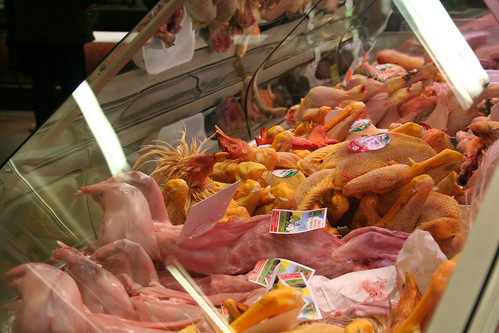
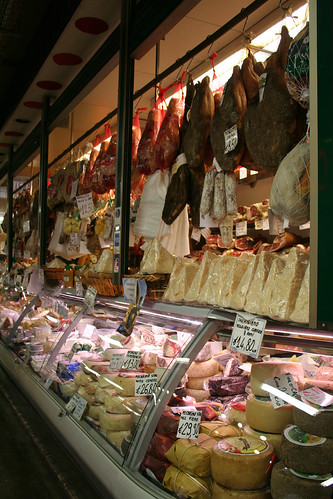
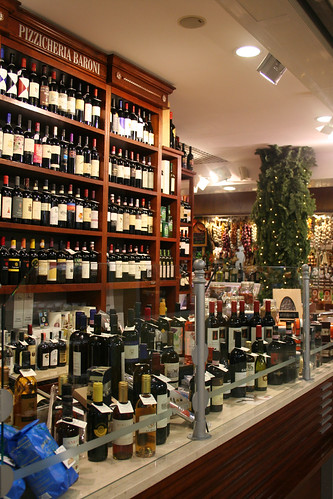
I bought two big green pears and two tender orange clementines, and then I went to the station to catch the next train to Lucca.
Lucca is two years shy of its 500th anniversary--it was once a Roman outpost, evidenced by the stone and earth walls that still surround the core of the city. Its character is similar to Florence, but more relaxed and intimate. It has a number of churches, and many small piazze with elegant Romanesque statues.
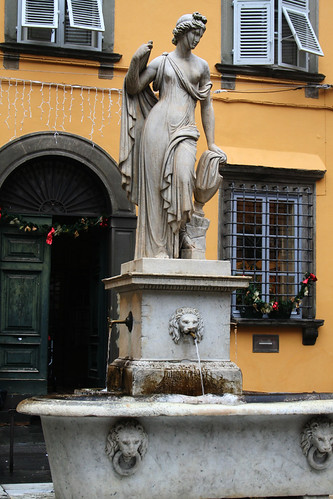
Near the center of the city core is Torre Guinigi, the tower of the palace belonging to one of the city's wealthy families of yore. It's a steep but relatively short climb to the top, from which you can see the entire city and beyond to the surrounding hills.
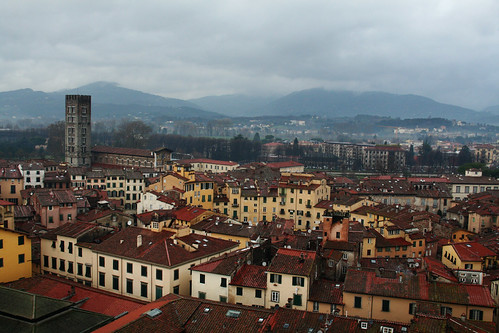
I was simply stunned.
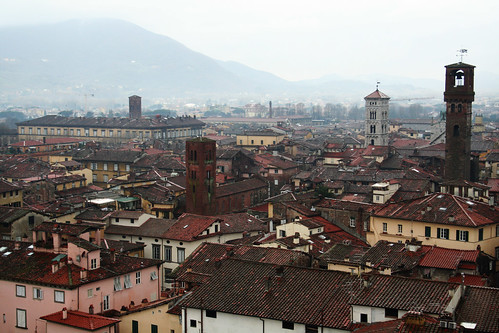
I mean, seriously.
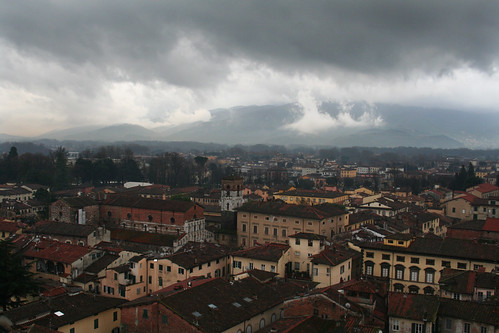
I was originally only planning on a day trip to Lucca, but it got late and I decided to find a place for the night instead of returning to Florence and trying to do the same. No complaints here! Lucca is simply beautiful.
Tomorrow: departing for Rome!



I bought two big green pears and two tender orange clementines, and then I went to the station to catch the next train to Lucca.
Lucca is two years shy of its 500th anniversary--it was once a Roman outpost, evidenced by the stone and earth walls that still surround the core of the city. Its character is similar to Florence, but more relaxed and intimate. It has a number of churches, and many small piazze with elegant Romanesque statues.

Near the center of the city core is Torre Guinigi, the tower of the palace belonging to one of the city's wealthy families of yore. It's a steep but relatively short climb to the top, from which you can see the entire city and beyond to the surrounding hills.

I was simply stunned.

I mean, seriously.

I was originally only planning on a day trip to Lucca, but it got late and I decided to find a place for the night instead of returning to Florence and trying to do the same. No complaints here! Lucca is simply beautiful.
Tomorrow: departing for Rome!
21 December 2010
Day 5: Uffizi e Loggia dei Lanzi
The snow is melting, and the temperature is consistently above freezing at last. The sun tried very hard to peek through the clouds, and there were patches of blue sky for a little while! Looking up and down the Arno on my walk to the Uffizi Gallery, there was a very thin, even fog over the whole city.
Photos were not allowed inside the gallery, but in the enormous Piazza della Signoria, adjacent to the museum and Palazzo Vecchio, there is an alcove with beautiful Roman statues, called Loggia dei Lanzi. It's essentially an outdoor museum, and contains statues from Antiquity and the Renaissance.
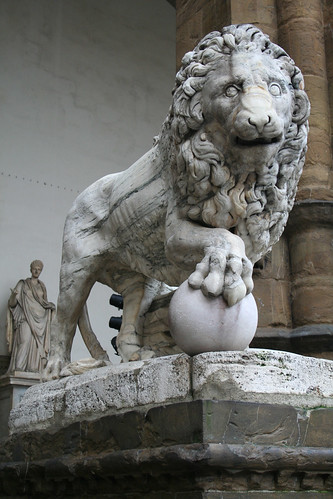
The steps into the alcove are guarded by a pair of lions. I found this interesting because of their similarity to the Chinese guardian lions situated in pairs outside of temples and palaces, which also hold a sphere (or, in the case of the female of the pair, a cub) in the inside paw.
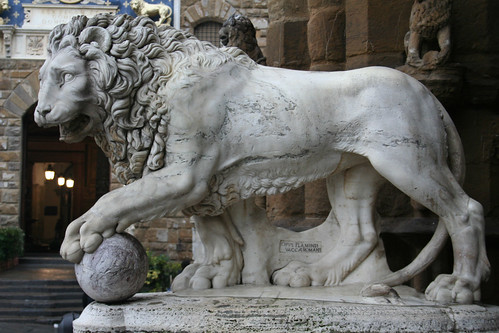
Menelaus supporting the body of Patroclus.
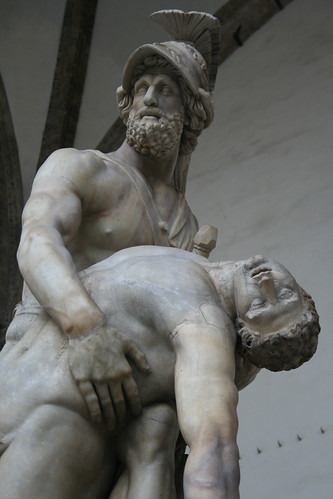
Perseus with the head of Medusa.
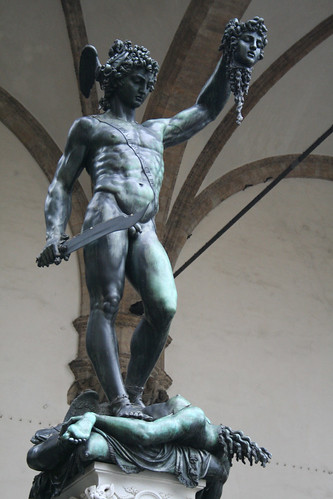
I loved all of the statues here, even those not pictured. They are kinetic, dynamic, even as they stand still. Many of the statues showed their subjects in motion, as if captured in the midst of a dramatic struggle.
Piazzale degli Uffizi is lined with statues of important figures in Italian (especially Florentine) history. My favorite was of Niccolo Macchiavelli.
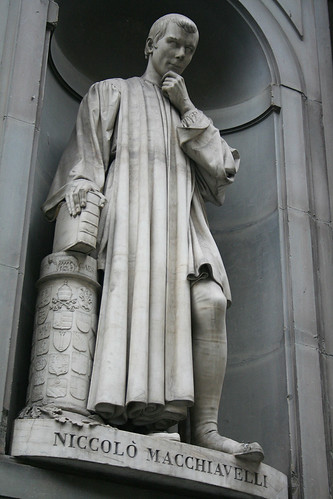
I love it because he looks so crafty.
The Uffizi Gallery was predominantly religious paintings and portraits of aristocracy, but also had a great array of Roman busts and sculptures. Paintings depicting Greek myth are, I think, my favorites, but there was a special exhibit of Artemisia Gentileschi, whose paintings were incredibly powerful and emotional--far more so than most of her male contemporaries.
Photos were not allowed inside the gallery, but in the enormous Piazza della Signoria, adjacent to the museum and Palazzo Vecchio, there is an alcove with beautiful Roman statues, called Loggia dei Lanzi. It's essentially an outdoor museum, and contains statues from Antiquity and the Renaissance.

The steps into the alcove are guarded by a pair of lions. I found this interesting because of their similarity to the Chinese guardian lions situated in pairs outside of temples and palaces, which also hold a sphere (or, in the case of the female of the pair, a cub) in the inside paw.

Menelaus supporting the body of Patroclus.

Perseus with the head of Medusa.

I loved all of the statues here, even those not pictured. They are kinetic, dynamic, even as they stand still. Many of the statues showed their subjects in motion, as if captured in the midst of a dramatic struggle.
Piazzale degli Uffizi is lined with statues of important figures in Italian (especially Florentine) history. My favorite was of Niccolo Macchiavelli.

I love it because he looks so crafty.
The Uffizi Gallery was predominantly religious paintings and portraits of aristocracy, but also had a great array of Roman busts and sculptures. Paintings depicting Greek myth are, I think, my favorites, but there was a special exhibit of Artemisia Gentileschi, whose paintings were incredibly powerful and emotional--far more so than most of her male contemporaries.
20 December 2010
Day 4: Museo e Cattedrale
I've been terribly indecisive about food here, and have gotten into a bad habit of wandering around, block after block, looking into shop and restaurant windows but never actually going into one until my feet and back start to hurt. Part of it is that I'm still intimidated by everything, and part is that there are just so many of them.
Lots of the big museums and things seem to be closed on Mondays, but the Museo del Duomo was open - I must've spent a good two hours wandering through it. This museum houses much of the art, sculptures, architectural structures, and relics that are no longer kept in the cathedral for whatever reason, as well as old blueprints and wooden models from the planning of the building itself. The Duomo was in construction for literally six hundred years, through the lifetimes of many architects and through multiple architectural and artistic styles, so it is very interesting to see how the plans for the building changed over time.
After the museum, I went into the Duomo - formally, la Cattedrale di Santa Maria del Fiore (Cathedral of St. Mary of the Flower) - itself, which was spectacular. Unfortunately, the light was extremely low, so the few photos I have are awfully grainy and uneven.
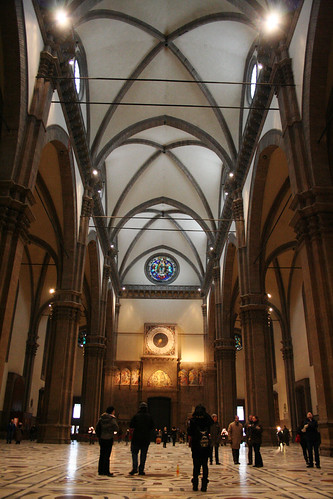
The inside of the Duomo itself is this huge, elaborate fresco.
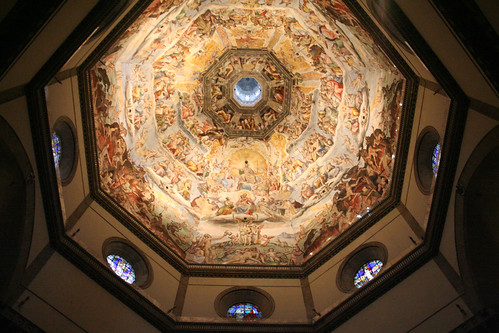
The Duomo was built on the ruins of a much, much older cathedral, that of Santa Reparata, which dates to the 4th or 5th century CE and was the Christian religious center of Florence up until the Middle Ages. From the Duomo, for a small fee, you can go down into the excavation of Santa Reparata, where some of the columns, mosaics, and stonework remain in situ.
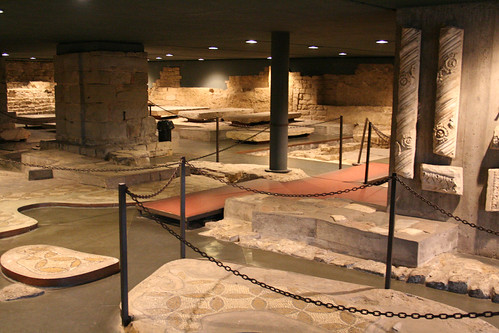
Out of all of the art and beauty that I witnessed today, this was certainly the most profound.
I thought about going to the top of the Duomo, but decided to wait for a day with clearer skies (and after walking beforehand a lot less). Tomorrow, I plan to hit the Uffizi Gallery and hopefully some others as well.
Lots of the big museums and things seem to be closed on Mondays, but the Museo del Duomo was open - I must've spent a good two hours wandering through it. This museum houses much of the art, sculptures, architectural structures, and relics that are no longer kept in the cathedral for whatever reason, as well as old blueprints and wooden models from the planning of the building itself. The Duomo was in construction for literally six hundred years, through the lifetimes of many architects and through multiple architectural and artistic styles, so it is very interesting to see how the plans for the building changed over time.
After the museum, I went into the Duomo - formally, la Cattedrale di Santa Maria del Fiore (Cathedral of St. Mary of the Flower) - itself, which was spectacular. Unfortunately, the light was extremely low, so the few photos I have are awfully grainy and uneven.

The inside of the Duomo itself is this huge, elaborate fresco.

The Duomo was built on the ruins of a much, much older cathedral, that of Santa Reparata, which dates to the 4th or 5th century CE and was the Christian religious center of Florence up until the Middle Ages. From the Duomo, for a small fee, you can go down into the excavation of Santa Reparata, where some of the columns, mosaics, and stonework remain in situ.

Out of all of the art and beauty that I witnessed today, this was certainly the most profound.
I thought about going to the top of the Duomo, but decided to wait for a day with clearer skies (and after walking beforehand a lot less). Tomorrow, I plan to hit the Uffizi Gallery and hopefully some others as well.
19 December 2010
Day 3: Siena, mi 'Spiace
Mi dispiace! No photos today. The attempted trip to Siena turned into a slight disaster due to my lack of understanding of Italian bus systems. I had the address of a nun-run hotel that I was planning to stop by, but attempting to follow the provided directions somehow left me at a bus stop on the outskirts of town. After spending hours hiking up and down icy hills and trying to find my way to the city center, I gave up, returned to the train station via street signs and dead reckoning, and caught the next train back to Florence to nurse my wounded ego.
I am exhausted, sore, a little overwhelmed, and sad to have lost an entire day to this, but I am really coming to love Florence--good, because I'll be spending a lot of time here starting in January--and I think I'll hang out here until it's time to head to Rome (hotel reserved starting the 23rd). I've found a comfortable youth hostel that I think will do for the next few days, and I'm excited to do some more in-depth sightseeing here.
Listening to Italians chatting on their cell phones can be entertaining, especially as they say their good-byes. They seem to like the word "ciao" as much as I do and will say it repeatedly, all mushed together, as a farewell. Most men stop at two repetitions (and I think this "ciaociao" is mostly reserved for girlfriends), but women may say it five or six times in rapid succession.
It's currently raining, which will either melt the snow or freeze it overnight into an icy deathtrap. Weather Underground reports rain and (for the most part) temperatures above freezing.
Tomorrow, conditions providing: let's go to some museums!
I am exhausted, sore, a little overwhelmed, and sad to have lost an entire day to this, but I am really coming to love Florence--good, because I'll be spending a lot of time here starting in January--and I think I'll hang out here until it's time to head to Rome (hotel reserved starting the 23rd). I've found a comfortable youth hostel that I think will do for the next few days, and I'm excited to do some more in-depth sightseeing here.
Listening to Italians chatting on their cell phones can be entertaining, especially as they say their good-byes. They seem to like the word "ciao" as much as I do and will say it repeatedly, all mushed together, as a farewell. Most men stop at two repetitions (and I think this "ciaociao" is mostly reserved for girlfriends), but women may say it five or six times in rapid succession.
It's currently raining, which will either melt the snow or freeze it overnight into an icy deathtrap. Weather Underground reports rain and (for the most part) temperatures above freezing.
Tomorrow, conditions providing: let's go to some museums!
18 December 2010
Day 2: Firenze Innevata part II
I woke to a brilliantly clear sky and the whole city covered in six or eight inches of snow. I checked out of Hotel Enza and wandered to the Piazza del Duomo for coffee and to see what it looked like covered in snow. Every street and sidewalk was thick with it.
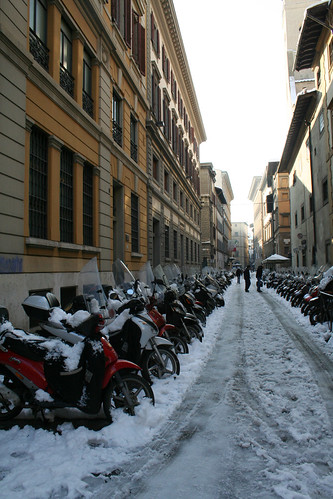
The Duomo itself was crowned white, a lovely compliment to the Christmas decorations all around it.
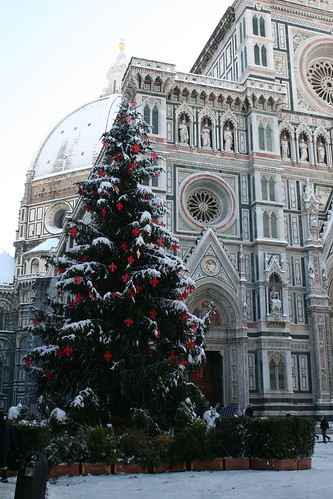
Incidentally, coffee. COFFEE. Espresso here is so delicious that it is beyond all possible comprehension. A shot of straight espresso goes down like water; a cappuccino is positively ambrosial. I don't know how I'll ever drink coffee in America ever again.
Today (December 18th) is my birthday, so I thought I'd walk to Ponte Vecchio and have a little picnic. I didn't bother with my map and just headed south to the river.
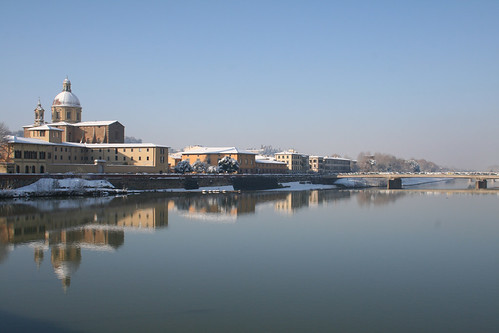
The Arno is the principal river in Tuscany and one of the largest in Italy, after the Tiber. About two thirds of Florence lies north of the Arno, where the major tourist areas are.
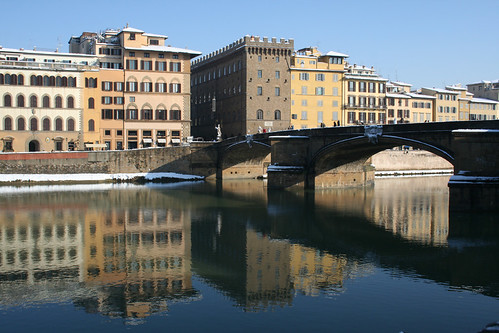
There are many, many bridges across it, but Ponte Vecchio is easy to spot; I just walked upstream (east) until I reached it.
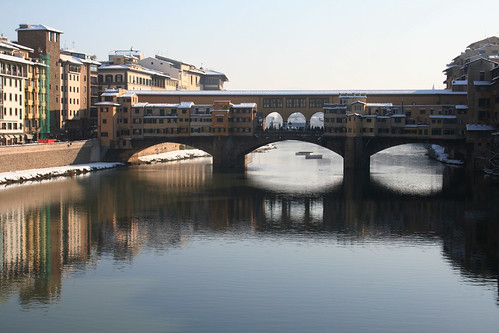
Ponte Vecchio (lit. "Old Bridge") is one of the few Florentine bridges not destroyed by the Germans during their retreat in WW2.

I bought a pizza margherita at a corner shop and walked around the neighborhood south of the bridge, looking in shop windows and watching other people, even locals, as enchanted by the snow as I was, take photos and throw snowballs.
Later, I ate a delicious ossobuco for lunch, followed by a big piece of tiramisu. I went to the station to validate my rail pass and head south to Siena, but the line was long and I missed the train by a few seconds (it pulled away literally as I was running to it). I waited around for the next one, but minutes before it would have arrived, the sign said it had been canceled - along with almost all of the other departures for the next hour! Not wanting to gamble on yet another, even later, train, I went in search of a hostel for the night. I'll try my luck with Siena tomorrow.

The Duomo itself was crowned white, a lovely compliment to the Christmas decorations all around it.

Incidentally, coffee. COFFEE. Espresso here is so delicious that it is beyond all possible comprehension. A shot of straight espresso goes down like water; a cappuccino is positively ambrosial. I don't know how I'll ever drink coffee in America ever again.
Today (December 18th) is my birthday, so I thought I'd walk to Ponte Vecchio and have a little picnic. I didn't bother with my map and just headed south to the river.

The Arno is the principal river in Tuscany and one of the largest in Italy, after the Tiber. About two thirds of Florence lies north of the Arno, where the major tourist areas are.

There are many, many bridges across it, but Ponte Vecchio is easy to spot; I just walked upstream (east) until I reached it.

Ponte Vecchio (lit. "Old Bridge") is one of the few Florentine bridges not destroyed by the Germans during their retreat in WW2.

I bought a pizza margherita at a corner shop and walked around the neighborhood south of the bridge, looking in shop windows and watching other people, even locals, as enchanted by the snow as I was, take photos and throw snowballs.
Later, I ate a delicious ossobuco for lunch, followed by a big piece of tiramisu. I went to the station to validate my rail pass and head south to Siena, but the line was long and I missed the train by a few seconds (it pulled away literally as I was running to it). I waited around for the next one, but minutes before it would have arrived, the sign said it had been canceled - along with almost all of the other departures for the next hour! Not wanting to gamble on yet another, even later, train, I went in search of a hostel for the night. I'll try my luck with Siena tomorrow.
Subscribe to:
Posts (Atom)
